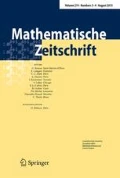Abstract
It was proved by F. Wilhelm that Gromov’s filling radius of closed positively curved manifolds with a uniform lower bound on sectional curvature attains the maximum with the round sphere. Recently the author proved that this is also the case for closed finite-dimensional Alexandrov spaces with a positive lower curvature bound. These were proved as a corollary of a comparison theorem for the invariant called spread of those spaces. In this paper, we extend the latter result to infinite-dimensional Alexandrov spaces.
Similar content being viewed by others
References
Alexander, S., Kapovitch, V. Petrunin, A.: Alexandrov geometry. Forthcoming textbook
Burago, D., Burago, Y., Ivanov, S.: A Course in Metric Geometry. Graduate Studies in Mathematics, vol. 33. American Mathematical Society, Providence, RI (2001)
Colding, T.: Large manifolds with positive Ricci curvature. Invent. Math. 124(1–3), 193–214 (1996)
Ekeland, I.: Nonconvex minimization problems. Bull. Am. Math. Soc. 1, 443–474 (1979)
Gromov, M.: Filling Riemannian manifolds. J. Differ. Geom. 18(1), 1–147 (1983)
Grove, K., Petersen, P.: A radius sphere theorem. Invent. Math. 112(3), 577–583 (1993)
Grove, K., Wilhelm, F.: Hard and soft packing radius theorems. Ann. Math. (2) 142(2), 213–237 (1995)
Kapovitch, V.: Perelman’s Stability Theorem. Surveys in Differential Geometry, vol. XI, pp. 103–136. International Press, Somerville, MA (2007)
Katz, M.: The filling radius of two-point homogeneous spaces. J. Differ. Geom. 18(3), 505–511 (1983)
Mitsuishi, A.: A splitting theorem for infinite dimensional Alexandrov spaces with nonnegative curvature and its applications. Geom. Dedicata 144, 101–114 (2010)
Perelman, G.: Elements of Morse theory on Aleksandrov spaces. Algebra i Analiz 5(1), 232–241 (1993) (Russian); translation in St. Petersburg Math. J. 5(1), 205–213 (1994)
Plaut, C.: Metric Spaces of Curvature \(\ge k\). Handbook of Geometric Topology, pp. 818–898. North-Holland, Amsterdam (2002)
Takatsu, A., Yokota, T.: Cone structure of \(L^2\)-Wasserstein spaces. J. Topol. Anal. 4(2), 237–253 (2012)
Wilhelm, F.: On the filling radius of positively curved manifolds. Invent. Math. 107(3), 653–668 (1992)
Yamaguchi, T.: Simplicial volumes of Alexandrov spaces. Kyushu J. Math. 51(2), 273–296 (1997)
Yokota, T.: A rigidity theorem in Alexandrov spaces with lower curvature bound. Math. Ann. 353(2), 305–331 (2012)
Yokota, T.: On the filling radius of positively curved Alexandrov spaces. Math. Z. 273(1–2), 161–171 (2013)
Acknowledgments
The author thanks Ayato Mitsuishi for discussions related to this work and the referee for his/her comments with which he hopes the readability of this paper was improved. This work was done during the author’s stay in the University of Münster. He thanks for its hospitality and stimulating research environment.
Author information
Authors and Affiliations
Corresponding author
Additional information
Partly supported by JSPS Postdoctoral Fellowships for Research Abroad.
Appendix
Appendix
As promised before, we present the proof of the following
Proposition 22
(cf. Perelman [11, Lemma 2.3]) Let \((\Sigma , \angle )\) be an Alexandrov space of curvature \(\ge 1\). Suppose that a family \(\mathcal {B}\) of subsets of \(\Sigma \) satisfies that \(\angle (B, B^\prime ) > \lambda > {\pi / 2}\) for each \(B \ne B^\prime \in \mathcal {B}\). We choose two elements \(B_+, B_- \in \mathcal {B}\). Then there exists \(w \in \Sigma \) such that \(\angle (w, B_+) > \lambda \), \(\angle (w, B_-) < \pi - \lambda \), and \(\angle (w, B) = {\pi / 2}\) for any \(B \in \mathcal {B}_0 := \mathcal {B}{\setminus } \left\{ B_+, B_- \right\} \).
Our proof of Proposition 22 relies on the following lemma.
Lemma 23
(Ekeland principle, e.g. Ekeland [4]) For any continuous function \(f: X \rightarrow \mathbb {R}\) on a complete metric space \((X, d)\) with \(\inf _{X} f > -\infty \) and \(\varepsilon >0\), we can find a point \(x \in X\) for which the following folds:
Proof of Proposition 22 We put
and for a small \(\varepsilon = \varepsilon (\lambda , \angle (B_+, B_-))>0\), we apply Proposition 23 to find \(w \in \Sigma ^0\) such that
We verify that \(w\) satisfies the required properties. Since \(\Sigma ^0\) is a closed subset of \(\Sigma \) containing \(B_-\) and \(\varepsilon \) is small enough, it is clear that
We suppose that \(\angle (w, B_0) > {\pi / 2}\) for some \(B_0 \in \mathcal {B}_0\). Choose \(w_{0} \in J_w\) near \(B_0\) and \(w^\prime \in (w, w_0)\) with \(\angle (w^\prime , w_0) > {\pi / 2}\). Then, by the triangle comparison and \(\tilde{\angle }_1 (w; w_0, v) > \lambda \) for any \(v \in B_+\), we deduce that \(w^\prime \in \Sigma ^0\) and
with \(\varepsilon _0 := -\cos \lambda \), which contradicts to the choice of \(w\) if \(\varepsilon < \varepsilon _0\). Thus implies that \(\angle (w, B) = {\pi / 2}\) for any \(B \in \mathcal {B}_0\).
If \(\angle (w, B_-) \ge \pi - \lambda \), then
with some abuse of notation, and we can derive a contradiction by the same argument. This finishes the proof. \(\square \)
Rights and permissions
About this article
Cite this article
Yokota, T. On the spread of positively curved Alexandrov spaces. Math. Z. 277, 293–304 (2014). https://doi.org/10.1007/s00209-013-1255-5
Received:
Accepted:
Published:
Issue Date:
DOI: https://doi.org/10.1007/s00209-013-1255-5


